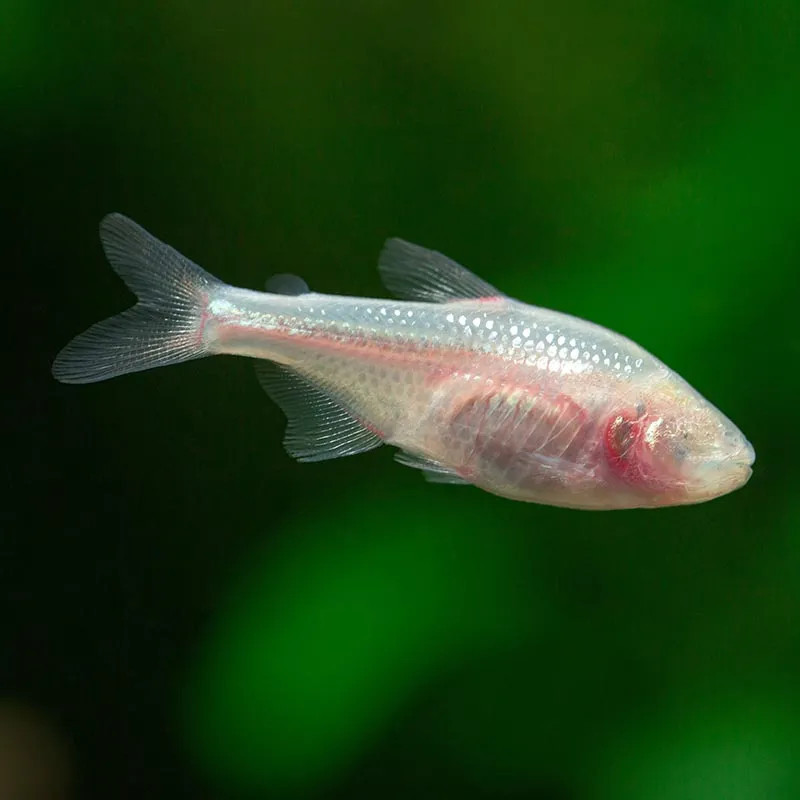Stocks Available
RED EYE TETRA
SKU:121661
MOENKHAUSIA SANCTAEFILOMENAE
1.25 INCH

Stock Available
Introduction: Species: Blind Cave Tetra (Astyanax mexicanus) Common Names: Blind Cave Tetra, Mexican Tetra Natural Habitat: Found in the caves of northeastern Mexico, these fish have evolved to live in total darkness, thriving in subterranean rivers and caves with no natural light. Physical Characteristics: Appearance: The Blind Cave Tetra is known for its lack of functional eyes, which are either completely absent or reduced to small vestigial structures. Their bodies are typically pale, often pink or white, due to the lack of pigment (melanin), which is unnecessary in their dark habitat. Despite their lack of vision, they have highly developed lateral lines that help them navigate and detect movement. Size: Grows up to 3-4 inches (7-10 cm) in length. Lifespan: Average lifespan of 3-5 years in captivity, with proper care. Habitat Requirements: Tank Size: A minimum of 20 gallons is recommended for a small group of Blind Cave Tetras. They are active swimmers and appreciate ample space. Water Conditions: Temperature: 68-77°F (20-25°C). pH: 6.5-8.0 (fairly adaptable to a range of water conditions). Aquascaping: Blind Cave Tetras do not rely on light, so tank lighting can be kept dim. Use smooth rocks, caves, and driftwood for decoration. Avoid sharp objects that could injure the fish, as they rely on their tactile sense. Diet: Primary Diet: Omnivorous; they eat a variety of foods in the wild, including small invertebrates and plant matter. Supplemental Feeding: In the aquarium, they thrive on a balanced diet of high-quality flakes or pellets, supplemented with live or frozen foods such as bloodworms, brine shrimp, and daphnia. Feeding Frequency: Feed small portions 1-2 times a day. Compatibility: Temperament: Blind Cave Tetras are peaceful and hardy, making them excellent candidates for community tanks. However, due to their lack of sight, they may sometimes nip at slower-moving tankmates in search of food. Suitable Tank Mates: They do well with other robust, peaceful fish such as Corydoras, Danios, or Rasboras. Incompatibilities: Avoid keeping them with slow-moving, long-finned fish, which may be mistaken for food due to their tactile feeding behavior. Care Level: Difficulty: Easy; their adaptability and resilience make them great for both beginner and experienced aquarists. Health Monitoring: Regularly monitor water quality and ensure the tank is free of sharp objects to prevent injury. They are generally healthy but may suffer from common freshwater ailments if the water quality is poor. Breeding: Breeding in Captivity: Blind Cave Tetras can be bred in captivity with proper conditions. They are egg scatterers, and their breeding setup should include plants or spawning mops for egg deposition. Spawning: After spawning, the eggs should be removed or the adults relocated to prevent them from eating the eggs. Economic Considerations: Market Demand: Moderate demand due to their unique appearance and ease of care. Their eyeless adaptation fascinates many aquarists. Wholesale/Retail Pricing: They are generally affordable and widely available in pet stores or online. Sustainability and Conservation: Wild Population: Not considered threatened in the wild, though their specific cave habitats are somewhat vulnerable to environmental changes. Aquaculture Efforts: Blind Cave Tetras are commonly bred in captivity, which reduces pressure on wild populations. Regulations: As with other aquarium fish, it's important to adhere to local and international trade regulations. Conclusion: The Blind Cave Tetra is a fascinating and unique addition to any aquarium, known for its eyeless adaptation and hardy nature. Their peaceful temperament and ability to thrive in a range of water conditions make them suitable for aquarists of all experience levels. With the right care and tank setup, Blind Cave Tetras can provide a striking and unusual element to any freshwater aquarium.
Data sheet
16 other products in the same category: